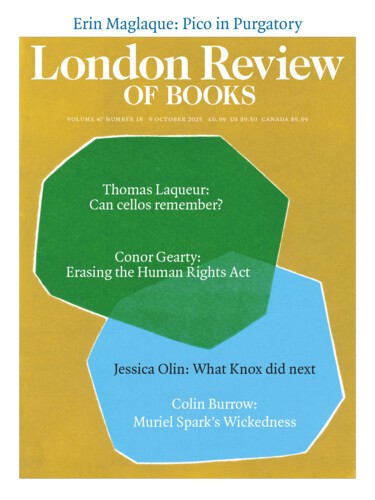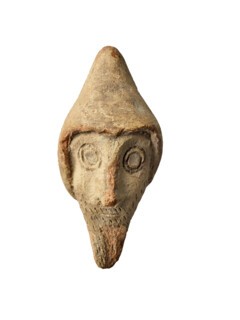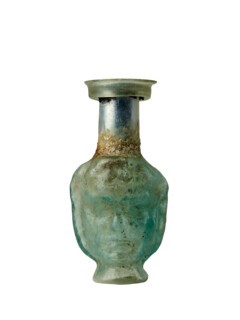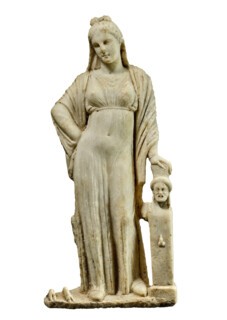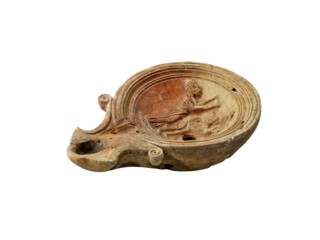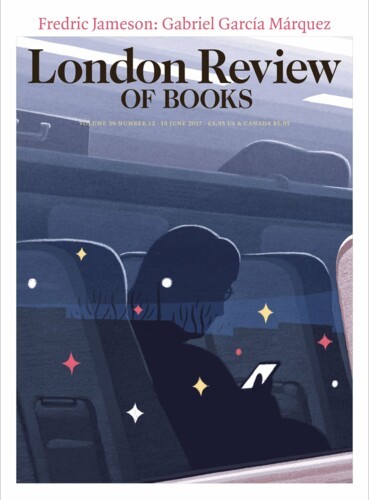There was a fashion in the Bronze Age Levant for decorating hollow bones: take the femur or tibia of a cow, scoop out the mucky stuff, polish it up and scratch geometric patterns on it. The bone tube – as archaeologists call such objects – on display in Paris as part of the exhibition Trésors sauvés de Gaza: 5000 ans d’histoire (until 2 November) has a boisterous design. Three sets of parallel horizontal lines encircle the cylinder to frame a small band of hatched diamonds and a larger band of fat stripy zigzags, all incised freehand with some panache. It looks like a miniature didgeridoo, but it doesn’t work like one: in fact no one really knows what they were for.
The bone tube is the earliest object in the exhibition. It comes from Tell es-Sakan, a large mound five kilometres south of Gaza City that was identified as an early Bronze Age settlement in 1998 during the building of new housing. Excavations began under the aegis of the Palestinian Authority’s Department of Antiquities and Cultural Heritage, which was four years old at the time. In collaboration with French archaeologists, the new department found a city of the fourth and third millennia bce with walls almost eight metres thick and buildings standing almost two metres high. At the same time, it was conducting other excavations in and around Gaza City. These included another French collaboration at ancient Anthedon, Gaza’s harbour, next to the Shatteh refugee camp, and a Palestinian-Swedish project at Tell es-Sakan’s successor site five hundred metres further south, Tell el-Ajjul, which was a major settlement in the second millennium and full of foreign imports. In addition to possessing its own good farmland and an important Mediterranean port, Gaza was on the land route from Egypt to Mesopotamia and was a gateway to Arabia in the last river valley before the desert.
Objects unearthed by Franco-Palestinian archaeological teams first arrived at the Institut du monde arabe for an exhibition called Gaza Méditerranéenne in 2000. By the end of that year, the period of relative calm that followed the Oslo Peace Accords in 1993 had come to an end with the failure of Camp David, Ariel Sharon’s provocative visit to the Temple Mount and the subsequent Second Intifada. The artefacts could not safely be sent back to Gaza. In 2007 they made it as far as Geneva for an exhibition at the Musée d’art et d’histoire, Gaza at the Crossroads of Civilisations, along with 260 artefacts lent by the businessman Jawdat Khoudary from his private museum in Gaza City. And there they remained for seventeen years, in relative safety but almost complete obscurity, crated up to go back to a home that now barely exists. Their return to Paris was prompted by the collapse of plans at the Institut du monde arabe for an exhibition on the ancient Levantine city of Byblos in 2024, when Israeli regional aggression made it unsafe to transport the agreed loans from Lebanon.
The theme of exile guides the utilitarian design of the new show. Around a hundred archaeological finds from Gaza are laid out in a ground-floor bunker space, complete with strip lights, cold grey-blue walls and chilly steel benches set awkwardly low. The cases, too, are functional, with only basic labels. Occasional brief explanatory texts are printed on the wall or carved on metal slabs leaning against it. Everything is in French: no pandering to the native languages of the objects here, let alone to tourists.
This is all in effective dissonance with the domestic scale of many of the artefacts, especially those from the earliest periods. Some reflect the traditionally close relations between Gaza and Egypt: a tiny soapstone scarab comes from the period in the 17th and 16th centuries bce when northern Egypt was ruled by Hyksos from the southern Levant; an alabaster globular pot dates from the 13th century, after Egypt had reunited and expanded to occupy Gaza. The harsh lighting gleams through the chalky white walls of the gypsum.
The Bronze Age ended with the retreat of the Egyptian army from Gaza. It is in this troubled period, during the 12th century bce, that Egyptian sources start to mention enemies called Peleset in the southern Levant. A few centuries later, the Hebrew Bible calls the same people Philistines, and describes them as being based in five city-states: Ashkelon, Ekron, Ashdod, Gath (Goliath’s home town) and Gaza. The exhibition text repeats the standard line from 20th-century scholarship that these Philistines were immigrants from elsewhere, probably the Aegean. This makes them one of the so-called Sea Peoples running around the Mediterranean in the aftermath of – perhaps even having caused – the collapse of Bronze Age civilisation.
But the Sea Peoples themselves are a flimsy 19th-century construct: no ancient Egyptian source goes further than describing some enemy groups, not including the Peleset, as ‘from the sea’. The reasoning behind the hypothesis that the Philistines had foreign origins is largely cultural – their preference for Cypriot fashions in pottery, for instance – or circumstantial, like an ancient DNA study published in 2019 showing that some unfortunate infants buried at Ashkelon in the 12th century bce had a foreign father or grandfather. But pots aren’t people, and the Levant has always been busy with sailors, traders and migrants who mixed easily with local populations. The view from the Hebrew Bible is different: when Abraham arrives in the promised land from his native city of Ur, a Philistine king is already there to meet him.
Wherever the Philistines were from, Gaza’s role as a crux of Afro-Eurasian trade continued into the Iron Age. There was still plenty of contact with Egypt, but other items reflect one of the brightest events of the Dark Age: the domestication of the dromedary in southern Arabia around 1000 bce. From as early as the ninth century, Assyrian documents describe a caravan route leading from the incense groves of modern Yemen (ancient Saba or ‘Sheba’) up through Mecca to the port of Gaza; here a plain, very fine ridged pot is typical of the Nabatean cameleers based in Petra and other desert strongholds and oases who brought frankincense and myrrh, along with Indian spices, from Arabian ports to the Mediterranean later in the same millennium.
Political autonomy was more fleeting, as Assyrians then Babylonians moved into the Levant, destroying cities and deporting populations. Mesopotamian documents mention communities of agricultural labourers named after Ashkelon and Gaza in the hinterland of Babylon. The Persian conquest of Babylon brought some respite, as Cyrus the Great allowed Babylonian deportees to return home, even if some chose not to do so: people in Babylon were still calling themselves ‘of Ashkelon’ and ‘of Gaza’ more than a century later. A Persian garrison was installed in Gaza itself, which may be the source of a small sculpted ceramic head with a pinched nose and round eyes, pointed at top and bottom into a soft Persian cavalry cap and a long beard, its hairs individually inscribed and painted black. Beside it in the same case sits the broken base of a fourth-century bce ceramic cup with Phoenician letters of the northern Levantine coast scratched onto its underside; there seems to have been a significant number of Phoenician-speaking, or at least Phoenician-writing, individuals in the southern cities in the post-Babylonian era.
After the Persians came Alexander, who besieged and sacked Gaza in 332 bce. Following his death, Gaza came under the control of his general Ptolemy, now king of Egypt, and from around 200 the Syrian Seleucids. Perhaps this was when a gorgeous marble Greek goddess was lost off the coast of Gaza, to be retrieved in the 20th century by a local fisherman. Clothed in a long draped dress and a cosy-looking shawl, from the front she looks perfect; you have to walk around the case to see the snaky encrustations of more than two thousand years underwater.
In 95 bce the city was sacked yet again, this time by the Hasmonean king of Judea, but by the turn of the first millennium Gaza and Judea had both been incorporated into the Roman Empire, and the Romans eventually renamed the whole region Palestina after the Philistines. Gaza remained a trading centre, famous above all for its wine, which travelled by land as well as sea: a small ruddy camel sculpture from the sixth century ce sits resting the burden of the wine jars hanging from his saddle. Late antiquity saw an intellectual renaissance in which Gaza also became a centre for the study of Greek literature and rhetoric, and the city’s long era of prosperity was uninterrupted by the Islamic conquest in 637.
The scale of the show shifts in these later periods, with large architectural fragments taking over the story. A knockout mosaic from the floor of a seventh-century church is missing large chunks but still teems with life: a border of waves encloses a vegetal pattern with hanging grapes and wandering fowl, studded with large roundels featuring local beasts. A lintel collected by Khoudary from a medieval Ottoman house in the Zaytoun district of Gaza City sets rosettes in a jagged tessellation of straight lines, somewhat reminiscent of the bone tube at the beginning, bordered by panels of meandering interlaced foliage.
The final object in the room is a late Roman column reworked as a British military tombstone for a lieutenant of the Bengal Lancers killed in 1917. It makes a neat transition to a second space downstairs, where a series of photographs, taken in Gaza by the Dominican Fathers of the French Biblical and Archaeological School at Jerusalem, includes several images of the damage done by British artillery bombardment that same year to the al-Umari mosque, once a Crusader church. The photographs are hazy period pieces compared to the violently coloured images taken in the last couple of years of bombed-out churches, mosques and museums that occupy much of the rest of this second room. But they tell a similar story, and the message is clear: 20th-century colonialism created the conditions for a 21st-century tragedy. Detailed documentation of the destruction of archaeological sites and collections across Gaza since October 2023 is presented poster-style, site by site. The photographs of bomb damage are juxtaposed with images of Palestinian archaeological excavations at the same places just a few years earlier.
This show has excited controversy: should we even be talking about damage to antiquities in the context of so much killing? The show’s maps dating from earlier this year, however, make it clear that targeting the history and heritage of the Palestinian people has been an intrinsic aspect of the Israeli assault on Gaza. Alongside 44 historical buildings and seven archaeological sites, all three depositories of historical and archaeological material in the Gaza Strip have been damaged or destroyed. The villa that housed Khoudary’s collection, which was donated to the Palestinian Authority in 2018, was occupied by the Israeli army, and the garden museum razed to make space for armoured vehicles. Much has gone for good, and what survives is at continual risk: 40 per cent of the West Bank town of Sebastia has just been expropriated for transformation into an Israeli archaeological park.
Finally, a small room in one corner shows simple but effective 3D video reconstructions of the Byzantine church of Mukheitim at Jabalia and the monastery of St Hilarion at Tell Umm el-‘Amr in their original landscapes. These are very different from the vast, lavish and almost entirely imaginary video-game style reconstruction of ancient Alexandria in the exhibition upstairs on Le Mystère Cléopâtre (until 11 January). I could hardly move for visitors to Cleopatra, but in the Gaza exhibition I frequently had the whole space to myself.
Send Letters To:
The Editor
London Review of Books,
28 Little Russell Street
London, WC1A 2HN
letters@lrb.co.uk
Please include name, address, and a telephone number.
